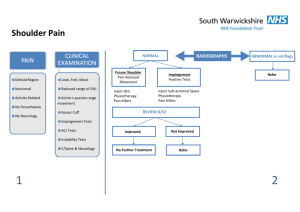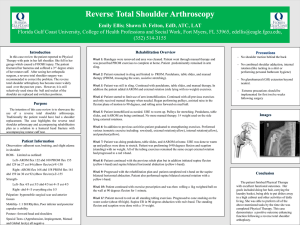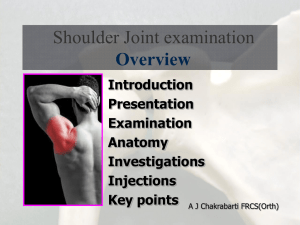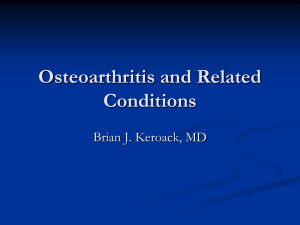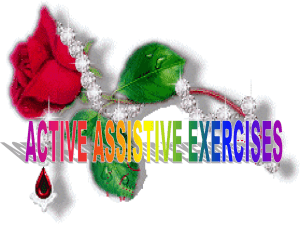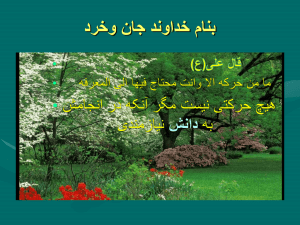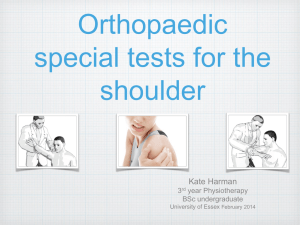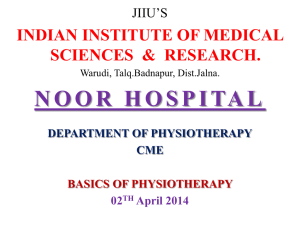Shoulder & Elbow assessment
advertisement
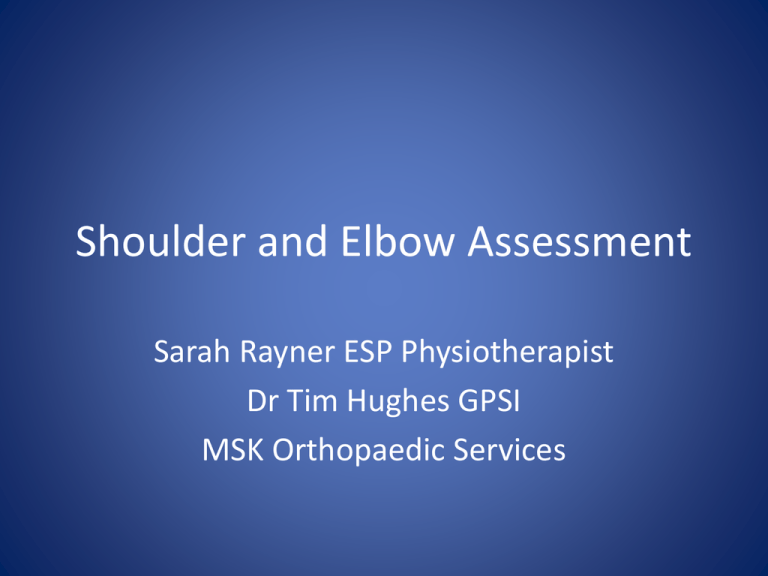
Shoulder and Elbow Assessment Sarah Rayner ESP Physiotherapist Dr Tim Hughes GPSI MSK Orthopaedic Services History Inspection, palpation Physical tests Make diagnosis & inform management History Consider at baseline: age, general health and co-morbidities, nature/mechanism of onset (trauma?), pain distribution, pain behaviour (e.g. night pain, inability to lie on affected side, dead arm syndrome, catching), aggravating/easing (e.g. overhead activities), stiffness, weakness, paraesthesia, joint sounds, functional impairments and previous treatments. Frozen shoulder SLAP lesion Anterior dislocation Primary GHJ osteoarthritis Bursitis Multidirectional instability Secondary GHJ osteoarthritis Tendinosis Posterior dislocation ACJ osteoarthritis Rotator cuff tear Fracture SCJ osteoarthritis Spinal accessory neuritis ACJ injury Joint laxity Suprascapular neuritis Neoplasm Subacromial impingement Long thoracic neuritis Referred pain from neck Internal impingement Parsonage-Turner syndrome Referred pain from viscera Anterior instability History Consider at baseline: age, general health and co-morbidities, nature/mechanism of onset (trauma?), pain distribution, pain behaviour (e.g. night pain, inability to lie on affected side, dead arm syndrome, catching), aggravating/easing (e.g. overhead activities), stiffness, weakness, paraesthesia, joint sounds, functional impairments and previous treatments. Frozen shoulder Recurrence likelier in younger individuals; often causes cuff tears in primary injury the older SLAP lesion Anterior dislocation Primary GHJ osteoarthritis Bursitis Multidirectional instability Secondary GHJ osteoarthritis Tendinosis Posterior dislocation ACJ osteoarthritis Rotator cuff tear Fracture SCJ osteoarthritis Spinal accessory neuritis ACJ injury Joint laxity Suprascapular neuritis Neoplasm Subacromial impingement Long thoracic neuritis Referred pain from neck Internal impingement Parsonage-Turner syndrome Referred pain from viscera Anterior instability Shoulder: Common conditions • Impingement • Rotator Cuff tears • Frozen shoulder • AC joint pain Shoulder Assessment Standard tests Observations • Deformity, wasting, heat, effusion, winging, bony contours Active movements • • • Neck x 6 (flex, ext, side flex and rot) Shoulder girdle elevation (SCJ, ACJ) Shoulder elevation (plus passive over-pressure) o Does the movement look “right”? o Is active range full? If not: o Is the joint stiff? o If the joint isn’t stiff, lost range may be due to weakness or pain. • o Painful arc? (impingement) Apley scratch test: hand down neck & hand up back (evaluate function) Passive movements • Lateral rotation* (capsular pattern) Isometric actions Resisted tests • • • • Abduction Adduction Lateral Rotation Medial Rotation Rotator cuff tests • • • • Full can test (supraspinatus) Drop sign (Massive RC tear) ER lag sign (supraspinatus) Lift off test /Belly press(subscapularis) Accessory tests (as required) • • Scalf Test (ACJ) Neer, Hawkins and Kennedy (impingement) Palpation for tenderness • As required * Restriction = summary of Cyriax’s “capsular pattern” Elbow Assessment Standard tests Observations • Deformity, wasting, heat, effusion, bony contours Active movements • • • • Neck x 6 (flex, ext, side flex and rot) Shoulder (elevation, HBB, LR) Elbow: flex/ext, pronation/supination Wrist: flex/ext, RD/UD o Is active range full? If not: o Is the joint stiff? o If the joint isn’t stiff, lost range may be due to weakness or pain. Passive movements • End feel, crepitus, pain Isometric actions Screening tests • Extension • Flexion Passive stretching • Combined elbow ext, wrist flex and pronation (stretches extensors) • Combined elbow ext, wrist ext and supination (stretches flexors) Accessory tests (as required) Palpation for tenderness • As required

